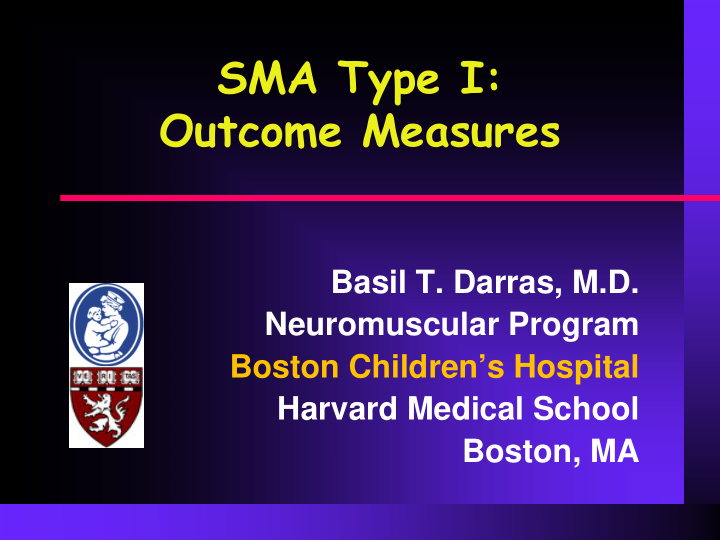



SMA Type I: Outcome Measures Basil T. Darras, M.D. Neuromuscular Program Boston Children’s Hospital Harvard Medical School Boston, MA
Financial disclosures Dr. Darras is the author of articles regarding neuromuscular diseases for UpToDate, Inc. UpToDate does not produce health-care related products or services. Dr. Darras has served as a consultant for Sarepta, Inc., AveXis, Inc., BMS, Inc., PTC Inc., Cytokinetics, Inc., Biogen, Inc., Marathon, Inc. and Roche, Inc, but has no financial interests in these companies; receives research support from PTC Therapeutics, Inc., Ionis Pharmaceuticals, Inc., the NIH (NIAMS, NINDS), the SMA Foundation, the Muscular Dystrophy Association, Working on Walking Org. and the Slaney Family Fund for SMA.
CHOP INTEND: Children’s Hospital of Philadelphia Infant Test of Neuromuscular Disorders Source: Jackie Montes, PT, Columbia Univ. Validated, 16 items, 64-point scale Shown reliable in SMA Type I subjects Derived in part from TIMP (Test of Infant Motor Performance) Designed to measure motor function in weak infants with neuromuscular disease Includes active (spontaneous, goal- directed) and elicited reflex movements
CHOP INTEND: Children’s Hospital of Philadelphia Infant Test of Neuromuscular Disorders Designed to move from easiest to hardest Does not include respiratory or feeding assessments Grading includes with gravity eliminated (lower scores) to antigravity movements (higher scores) Scores range from 0-4 in all items Completed in short period of time, well tolerated
Scoring Sheet
CHOP INTEND: Children’s Hospital of Philadelphia Infant Test of Neuromuscular Disorders SMA Type I infant average baseline score: 20–22 out of 64 points Infants with 2 copies of SMN2 : no baseline value over 40 points Score above 50 may correlate with sitting milestone Used successfully in ASO (Ionis/Biogen) and gene therapy (Avexis) Type I clinical trials
NeuroNEXT Baseline Results
PNCR NH Study: CHOP INTEND Longitudinal Data Subjects enrolled within 3 months of symptom onset (“recent”) Subjects enrolled more than 3 months after symptom onset (“chronic”)
NeuroNEXT: Longitudinal CHOP-INTEND Data Courtesy of Dr. Steven J. Kolb, OSU
Courtesy of Dr. Steven J. Kolb, OSU
TIMPSI: Test of Infant Motor Performance Screening Items 29 items, 99-point scale Valid and reproducible in SMA Type I infants Tests rolling, crawling, not sitting, and includes many items in prone position Not well tolerated by Type I infants Overlaps with CHOP INTEND Has been used in Biomarker NNext SMA 101 study but not in clinical trials
AIMS: Alberta Infant Motor Scale 58-item observational scale Developed to assess motor development in children from birth to independent walking Includes many items in prone position Used in Pompe’s disease clinical trial Used in NeuroNEXT infant biomarkers study to evaluate infants scoring high on TIMPSI No infants with 2 copies of SMN2 received AIMS in NeuroNEXT study (too weak)
AIMS: Alberta Infant Motor Scale
Motor Function Testing Algorithm Courtesy of Dr. Steven J. Kolb, OSU
Bayley Scales of Infant Development Includes assessment of fine and gross motor function, cognition, language Bayley-III language assessment includes receptive and expressive language Bayley-III motor assessment includes scale scores for fine and gross motor development Normative data available Advantage: can also assess fine motor, cognition, and language (receptive and expressive)
HINE: Hammersmith Infant Neurological Examination Neurological exam for infants 2–24 mo 37 items in 3 sections Section I: Neurological examination Section II: Developmental milestones Section III: Behavioral scale, state of consciousness Pure motor milestone test Not developed specifically for SMA, not validated in SMA
HINE: Hammersmith Infant Neurological Examination Used as exploratory outcome measure in Ionis CS3A open label Type I study Used as primary outcome measure in ENDEAR Ionis CS3B study of Nusinersen
Developmental Milestones
HINE Section II: Developmental milestones
CMAP: Compound Muscle Action Potential Summation of all motor unit potentials with supramaximal stimulation of the nerve innervating a particular muscle Used in recent SMA Type I clinical trials as electrophysiological biomarker
CMAP Compound Muscle Action Potential Correlates with age, motor function, and SMN2 copy number (Swoboda et al., Ann Neurol 2005) Symptomatic Type I patients: reduced CMAP amplitudes remain low over time Presymptomatic infants: CMAP amplitudes normal with subsequent precipitous decline
CMAP Compound Muscle Action Potential Used in NeuroNEXT SMA infant biomarker study Average CMAP peak amplitudes: • entire SMA cohort: 1.4 mV • SMA patients with 2 copies SMN2: 0.5 mV • control cohort: 5.5 mV Entire SMA cohort had positive correlation between CMAP amplitude values and motor functional ability
CMAP Peak Amplitude (mV) Courtesy of Dr. Steven J. Kolb, OSU
Recommend
More recommend